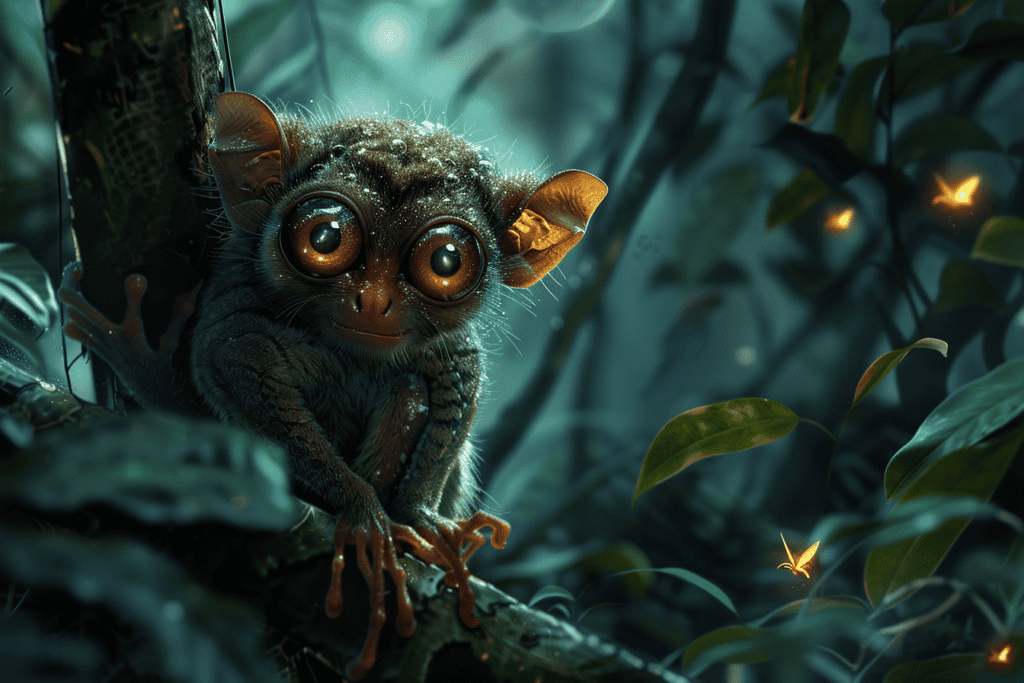Tarsiers, with their enormous eyes, are masters of nocturnal hunting. Their eyes, the largest relative to body size among mammals, lack a reflective layer but boast specialized retinas and rod cells.
This unique combination lets them see clearly in the dark, perfect for spotting insects. Large pupils gather maximum light, while their extraordinary depth perception aids in quick, precise captures.
Tarsiers can also rotate their heads up to 180 degrees, scanning their surroundings without moving, enhancing their stealth. These adaptations have made them incredibly efficient hunters.
Anatomy of Tarsier Eyes

Tarsiers’ eyes are remarkably large, measuring about 1.5 cm in diameter, which is the largest relative to body size of any mammal.
This unique eye anatomy is essential for their survival as nocturnal animals. Imagine having eyes so big that they dominate your face! These large eyes help tarsiers spot prey in the dark, giving them exceptional hunting abilities.
Unlike many other nocturnal creatures, tarsiers lack a tapetum lucidum, the reflective layer that enhances night vision. Instead, they rely on their specialized retinas and large pupils to maximize light intake.
You might wonder how these small primates manage without the tapetum lucidum. Well, their large eyes compensate by capturing more light, which is vital for detecting even the slightest movements of their prey.
This adaptation allows them to be incredibly efficient nocturnal hunters. Their retinas are packed with rod cells, which are highly sensitive to low light conditions, further enhancing their night vision.
This unique eye anatomy doesn’t just help with hunting; it also influences their overall behavior. With eyes that never miss a beat, tarsiers are always alert, ready to pounce on unsuspecting insects or small vertebrates. Their large eyes truly make them masters of the night.
Night Vision Adaptations

One of the key adaptations for night vision in tarsiers is their large pupils, which allow them to capture maximum light.
With their big eyes, tarsiers hold the record for the largest eyes relative to body size of any mammal. This unique adaptation gives them an exceptional night vision, essential for their nocturnal hunting lifestyle.
Imagine the Spectral Tarsier, perched silently in the dense forest, its enormous eyes scanning the darkness. These primates don’t just have big eyes for show. Their eyes’ size allows them to spot even the slightest movements of insects and small prey in low light conditions.
Unlike many other nocturnal animals, tarsiers lack a reflective eye layer, called the tapetum lucidum, which means they rely solely on their eyes’ ability to capture light. This gives them a unique advantage as they can detect and react to prey more quickly and accurately.
Their night vision is so well adapted that they can efficiently hunt in the pitch black, making them formidable nighttime predators. So, when it comes to nocturnal hunting, the tarsier’s massive, light-catching eyes are its secret weapon for survival.
Tarsier Nocturnal Hunting Strategies

With their unparalleled nocturnal vision, tarsiers employ a variety of hunting strategies to secure their prey. Their large eyes provide enhanced vision, essential for spotting small insects during their nocturnal hunts. This exceptional night vision means they can detect the slightest movements in the dark, giving them a significant advantage in prey detection.
One of the key hunting strategies tarsiers use is their excellent depth perception. Their large eyes allow them to accurately judge the distance to their prey, ensuring precise and swift captures. This ability is particularly important for their carnivorous diet, which depends on catching fast-moving insects and small animals.
Tarsiers’ eyes lack the reflective layer, or tapetum lucidum, found in many other nocturnal animals. This absence means they can hunt without their eyes glowing in the dark, making them less detectable to their prey. This stealthy approach enhances their success during nocturnal hunts.
Their unique eye structure lets them spot and capture prey with remarkable efficiency. Whether leaping from branch to branch or remaining motionless before a sudden strike, tarsiers’ hunting strategies are finely tuned to their environment, ensuring they thrive in their nocturnal world.
Comparison With Other Nocturnal Animals

While tarsiers’ head rotation is impressive, their enormous eyes set them apart from other nocturnal animals like owls. Unlike many nocturnal creatures, tarsiers lack a reflective eye layer known as the tapetum lucidum. This layer in other animals, such as cats and owls, reflects light back through the retina, enhancing vision in low light. But tarsiers don’t need this feature.
Their giant eyes, the largest relative to body size of any mammal, allow more light to enter directly, giving them exceptional night vision. In the world of nocturnal animals, this difference in comparative anatomy is striking. Owls, for example, rely on the tapetum lucidum for vision enhancement during nighttime hunting.
Tarsiers, however, achieve superior night vision through their massive eyes alone. This unique adaptation enables them to spot prey, like insects and small mammals, with incredible clarity in the dark.
Conservation Of The Tarsier

Amidst increasing threats from habitat loss and human activities, tarsiers’ conservation status has become a critical concern.
These endangered primates face numerous challenges, with populations dwindling due to deforestation and mining.
The Sangihe tarsier, in particular, is highly vulnerable, making conservation efforts more urgent than ever.
Classified as a threatened species by the IUCN, tarsiers need immediate action to secure their survival. Habitat loss remains a primary threat, with vast areas of their natural environments being destroyed.
Without intervention, the delicate ecosystems tarsiers depend on could vanish, leading to their extinction. Conservation efforts play a pivotal role in protecting these unique creatures. Establishing protected areas is essential to provide safe havens where tarsiers can thrive.









